
“A Perfect Summer Day,” Thomas Kinkade
Katie Hutchison, an architect, has written on the subject of what elements add up to create a charming house. The language she uses is a bit vague (I suspect she was trying to make the subject sound more complicated than it really is, as though an architect’s expertise is needed to define charm), but she makes a good start on the subject. Another way to examine the ingredients of charm is to study the paintings of Thomas Kinkade. His cottages have charm in abundance.
Let’s look at a couple more of Thomas Kinkades cottages, then apply Katie Hutchison’s criteria.

“Autumn at Ashley’s Cottage,” Thomas Kinkade

“The Good Shepherd’s Cottage,” Thomas Kinkade
Katie Hutchison gives five criteria for a charming house:
1. Grounding roof lines. What she means by this is a little vague to me, but I think she means that, even though the roof may be tall, the eaves should come close to the ground to keep the house on a human scale.
2. Legible massing. Again, her terms are vague, but I think by this she means that the shapes of the cottage should be simple and easy to understand.
3. Engaged relationship with landscape. Yes. This is easy to understand.
4. Simple color palette and harmonious materials. Yes. Also easy to understand.
5. Thoughtful details. Yes. This makes sense too.
If we apply these criteria to Kinkade’s cottages, I think it’s clear enough that Hutchison’s criteria always seem to apply.
Now here’s the gothic revival cottage I plan to build:
Keeping Hutchison’s criteria in mind, I propose some practical things to keep in mind if one is trying to build a house with storybook charm:
1. The house should be two stories tall, with a steep roof and low eaves.
2. The roof may make up half or more of the house’s façade, so it is critical that every element of the roof be as interesting as possible.
3. There must be dormers.
4. The windows must create some drama and make the interior seem intriguing.
5. The house should be set against woods, with trees behind or beside the house that are taller than the house itself. These trees should be of a variety of species.
6. There must be a profusion of blooming plants around the house, arranged in organic shapes, never in straight lines. Some climbing vines should be included. Lawns should be small and should fade back into the woods.
7. There should be meandering paths.
8. Chimneys, and chimney pots, are important.
9. Rustic fencing, either of stone or timber, is important.
I believe my house plan, and the land I’m building on, have all the basic ingredients. Landscaping will have to supply the rest.

